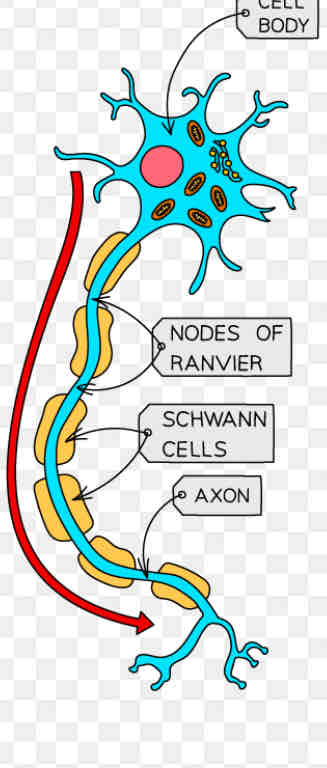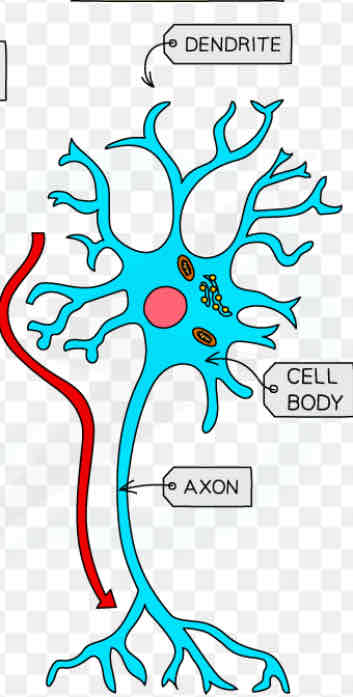A-Level Biology NERVOUS SYSTEM
1/15
Earn XP
Description and Tags
Name | Mastery | Learn | Test | Matching | Spaced |
|---|
No study sessions yet.
16 Terms
Structure of a neurone
cell body
Dendrons - short extensions combing from the cell body
Axons- long nerve fibres that transmit impulses away from the cell body
Different types of neurones
sensory neurones - transmit impulses from a sensory receptor cell to a relay/motor neurone or the brain
Relay neurones - transmit impulses between neurones
Motor neurones - transmit impulses from a relay/sensory neurone to an effector
Electrical impulse pathway
receptor
Sensory neurone
Relay neurone
Motor neurone
Relay neurone

Which neurone is this
Motor neurone

Which neurone is this
Relay neurone

Which neurone is this
Sensory neurone
What is the myelin sheath made of
Schwann cells
Purpose of myelinated sheath
Conducts electrical impulses at faster speeds compared to non myelinated neurones as they allow for saltatory conduction between nodes of ranvier
Pacinian corpuscle
Specific sensory receptors which detect mechanical pressure
How does the pacinian corpuscle convert mechanical pressure into a nervous impulse
in normal state, stretch mediated Na+ channels are too narrow for Na+ to move pass them, the neurone of the pacinian corpuscle has a resting potential
When pressure is applied, the corpuscle changes shape, causing membrane surround the neurone to stretch
Stretch mediated Na+ channels widen, allowing Na+ to diffuse into the neurone
Influx of Na+ channels causes the membrane to become depolarised
This creates an action potential which passes along the sensory neurone
What is the resting potential across the membrane
-70mV
How is a resting potential formed
Na+ ions are actively pumped out of the axon whilst K+ ions are actively transported in at a ratio of 3:2
This means there are more Na+ ions outside the membrane compared to inside the axon cytoplasm
As the axon cytoplasm is more negative, Na+ ions move down an electrochemical gradient whereas K+ ions diffuse out the axon
However, most of the VG Na+ ion channels are closed whilst K+ channels are open, this means the amount of positive ions outside of the axon is greater than inside, creating the -70mV resting potential
What is the depolarisation charge
+40mV
How does an action potential occur
Protein channels in axon membrane change shape as a result of a voltage across a membrane
Outline process of action potential
Neurone has a resting potential of -70mV, it is not transmitting an impulse, some K+ channels are open but VG Na+ channels are closed
Energy of the stimulus triggers some VG Na+ channels to open, making the membrane more permeable to Na+ ions, Na+ ions diffuse into the axon down an electrochemical gradient making inside the neurone less negative
This change in charge causes more Na+ ions to open, resulting in a positive feedback loop
When potential difference reaches +40mV, VG Na+ channels close and VG K+ channels open
K+ ions diffuse out of the axon down an electrochemical gradient resulting the inside of the axon becoming more negative
Hyperpolarisation occurs which causes Na+-K+ pump to open and move K+ in the axon, causing it to return to resting potential- repolarised